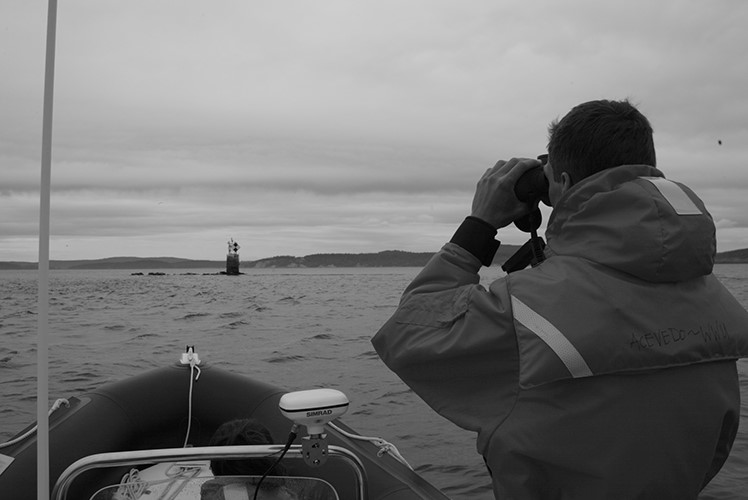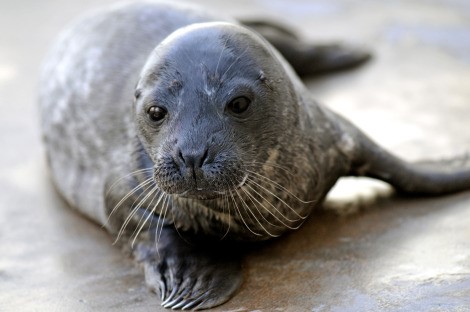March 2016
A seal's perspective
Raven Benko, undergraduate student
29 March 2016
Upon continuing my journey into the literature on humans influence on harbor seal, pinniped, and marine mammal behavior, I thought I would share a bit of my findings on the influence of pedestrian traffic and how it relates to our case at the Log Pond. Harbor seals spend a large amount of time out of water on land, docks, floating logs – as was once the case for our study site – and rely on this habitat for various life history processes. Haul-out sites are frequented during reproductive events such as birthing and rearing of young (Thompson 1989), resting (Da Silva and Terhune 1988), and to aid in moulting (Reder et. al. 2003). Of course, there is tons research on the affects of pedestrian and boat traffic, noise pollution, airplane proximity, and other such anthropogenic activities on behavioral and dispersal patterns of harbor seals and other marine mammals. What was most interesting to me was that even those of us standing a distance away –possibly studying their behavior, tracking their population, or simply admiring their attractive coats– can have a profound effect on seal behavior.

Harbor seal survey, San Juan Islands, WA, USA.
WWU Marine Mammal Ecology Lab
Photo: A. Banks
In a 2013 study measuring the response of harbor seals to sporadic and controlled pedestrian, boat, low-flying airplane, and grey seal disturbance, the authors found that pedestrian activities alone had a significant affect on harbor seal behavior, provoking a longer time spent as sea away from the haul-out site (Andersen et. al. 2014). Another study by the same authors used behavioral responses of harbor seals to boat and pedestrian traffic to recommend a geographical boundary for a Denmark harbor seal reserve. This study found that harbor seals were alerted to and fled from boat traffic at farther distances than pedestrian traffic (Andersen et. al. 2012). Both disturbance types elicited a flight behavior in which the seals left their haul-out site. Harbor seals responded to pedestrian disturbance even at distances as far as 260m (Andersen et. al. 2012)! This study was conducted during important reproductive periods just before pups were born, during nursing periods, and at the end of the moulting season (Andersen et. al. 2012). It is very important to have consistent haul-out sites during these life cycles stages, and these two studies begged me to question whether or not our presence in the log pond during all times of the season were having similar effects on harbor seal behavior. We hadn’t noticed any mass fleeing events when our single observers went out on an observation, but then again it has never been directly studied at the Log Pond. Sadly, with our haul-out site all but eradicated, we may never be able to study this interesting interaction. However, we do have more large-scale anthropogenic events occurring that can continue to give us some insight into the degree of disturbance tolerated by our population of harbor seals in Bellingham Bay.

Harbor seal pup, SeaWorld San Diego.
Photo: www.zooborns.com
The vast amount of research being done in the field of human disturbance on marine life is really amazing, and I haven’t been able to scratch the surface but I will continue to add interesting little tidbits as our project progresses. I simply found it fascinating that seemingly trivial human interaction could disrupt seals resting on their much depended upon haul-out sites. Hopefully our study has gone unnoticed by our seal population, and I am suspecting this is the case seeing as harbor seals return to the Log Pond location every year. If we are able to quantify the pedestrian traffic at the site as construction continues, it would be interesting to see how our seals respond. Given they are lacking a haul-out site, they may abandon the site all together. More to come in April!
References:
- Andersen, S. M., J. Teilmann, R. Dietz, N. M. Schmidt & L.A. Miller. 2012. Behavioural responses of harbour seals to human-induced disturbances. Aquatic Conservation: Marine and Freshwater Ecosystems 22: 113-121.
- Andersen, S.M., J. Teilmann, R. Dietz, N.M. Schmidt & L.A. Miller. 2014. Disturbance-induced responses of VHF and Satellite tagged harbour seals. Aquatic Conservation: Marine and Freshwater Ecosystems 24: 712-723.
- Da Silva, J & J. M. Terhune. 1988. Harbor seal grouping as an anti-predator strategy. Animal Behaviour 36: 1309–1316.
- Reder, S, C. Lydersen, W. Arnold & K. M. Kovacs. 2003. Haul-out behaviour of High Arctic harbour seals (Phoca vitulina vitulina) in Svalbard, Norway. Polar Biology 27: 6–16.
- Thompson, P. M. 1989. Seasonal changes in the distribution and composition of common seal (Phoca vitulina) haul-out groups. Journal of Zoology 217: 281–294.